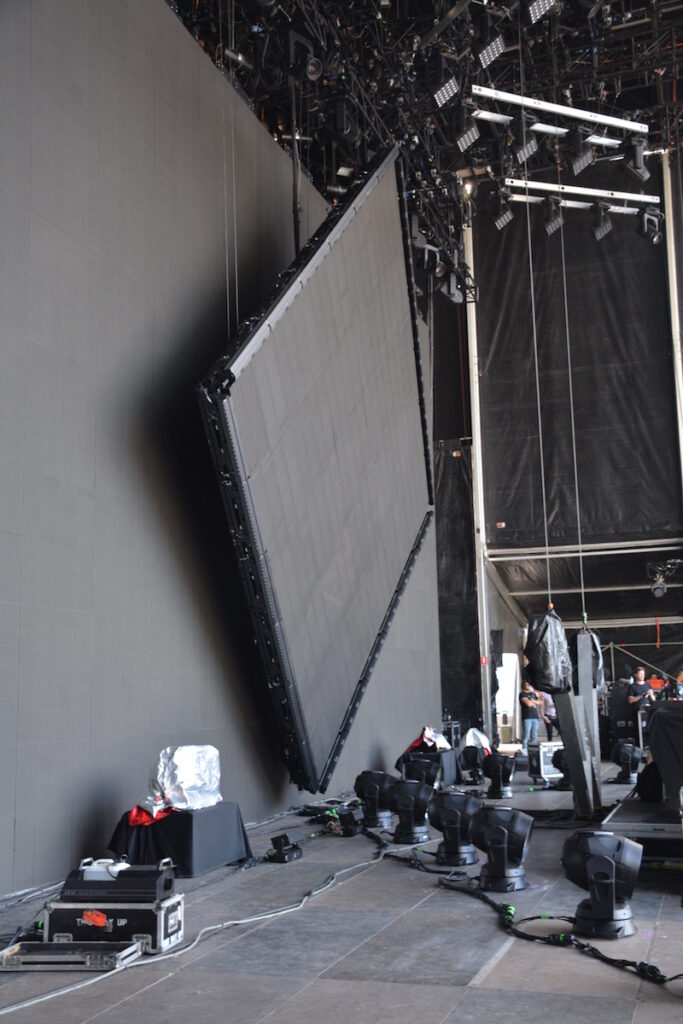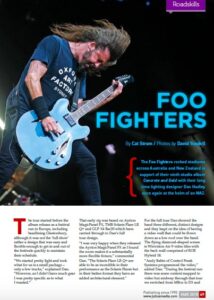News
15 Mar 2018
Foo Fighters

Subscribe to CX E-News
Road Skills
Foo Fighters
By Cat Strom / Photos by David Youdell
The Foo Fighters rocked stadiums across Australia and New Zealand in support of their ninth studio album Concrete and Gold with their long time lighting designer Dan Hadley once again at the helm of an MA2.
The tour started before the album release as a festival run in Europe, including headlining Glastonbury, although it was not the ‘full show’ rather a design that was easy and flexible enough to get in and out of the festivals quickly to maintain their schedule.
“We started pretty light and took what for us is a small package – only a few trucks,” explained Dan. “However, as I didn’t have much gear I was pretty specific as to what I wanted.”
That early rig was based on Ayrton MagicPanel FX, TMB Solaris Flare LR Q+ and GLP X4 Bar20 which have carried through to Dan’s full tour design.
“I was very happy when they released the Ayrton MagicPanel FX as I found the zoom makes it a substantially more flexible fixture,” commented Dan. “The Solaris Flare LR Q+ are able to be as incredible in their performance as the Solaris Flares but in their batten format they have an added architectural element.”
For the full tour Dan showed the band three different, distinct designs and they leapt on the idea of having a video wall that could be flown down as a low roof over the band. The flying diamond-shaped screen is Winvision Air 9 video tiles with the back wall comprised of ROE Hybrid 18.
“Andy Babin of Control Freak Systems programmed the video,” added Dan. “During the festival run there was some content mapped to video but midway through that tour we switched from MBox to D3 and Notch in a very tight turn around – actually one overnighter in Latvia!”
 Twenty-four GLP X4 Bar20 edge the diamond screen with six GLP X4 located on each side of the stage, supplying background for cross stage camera shots thus avoiding a black void or a roadie tuning a guitar. There are also GLP X4 on the downstage truss for general stage wash and picking up some other spots when the PRG GroundControl is being deployed elsewhere.
Twenty-four GLP X4 Bar20 edge the diamond screen with six GLP X4 located on each side of the stage, supplying background for cross stage camera shots thus avoiding a black void or a roadie tuning a guitar. There are also GLP X4 on the downstage truss for general stage wash and picking up some other spots when the PRG GroundControl is being deployed elsewhere.
The MagicPanel FX are rigged on twelve separate ladders, with each ladder holding three MagicPanel FX and one PRG Icon Edge. The ladders were custom built so that the rungs on which the fixtures are hung are free from the ladders that they pivot.
That way the lights always maintain their vertical position no matter what position the ladder is in. It allowed them to cut down on the infinite number of focuses that tilting a truss can give you and make a headache of your day.
“That’s something I have screwed myself with a couple of times before,” admitted Dan. “The band love having stuff flying around but it can lend to an extremely long process of focusing.”
The MagicPanel FX are run in extended mode with Dan programming all the effects, only a couple of times using the prebuilt macros, with no video mapping. Dan was exclusively using PRG’s GroundControl system for followspots: five Best Boys on the front truss, one in the grid for backlighting the ever moving Dave Grohl and a couple of long throws located on the delay towers.
“Being able to control long throw spots and to have the ability to control their intensity to such a degree, without having to stop my brain to communicate with someone else, is irreplaceable,” he said.
 “The Best Boy spots allow me to keep my general intensity down as I don’t have to wash a large area. I’ve never had a spot for each guy from FOH because I don’t like that angle – it casts odd shadows and is cumbersome from an operational point of view.
“The Best Boy spots allow me to keep my general intensity down as I don’t have to wash a large area. I’ve never had a spot for each guy from FOH because I don’t like that angle – it casts odd shadows and is cumbersome from an operational point of view.
“Having a consistent angle keeps the band from being surprised and Dave’s not a fan of FOH spots as he loves to see the crowd. I’m not a fan of calling spots and I’m not very good at it so the PRG GroundControl helps out a lot!”
Not wanting to add another fixture to the already eclectic mix, and to keep colour temperatures and palettes consistent, Dan added Best Boys as his main profile fixture to the rig. Eight Bad Boys per side are located on the wings above the IMAG screens whilst at the bottom are six Vari-lite VL6000.
“It’s important for Dave to be able to see the crowd so as well as the Bad Boys we have the Solaris Flare LR Q+ and Chauvet Strike1 and they give me a bunch of different options,” said Dan.
“It’s a long show and if I just populate the front truss with 8-lites that would get downright annoying. Being bashed in the face over and over by a bunch of orange LEGO is no fun so we invested in quite a few options and it has turned out really well.”
Dan was super impressed with the Chauvet Strike1 fixtures saying that you wouldn’t know they weren’t incandescent if he didn’t strobe them. “They colour shift to a redder tone at lower intensities and it’s simply a different look to a two, four or eight lite,” he said. “They have nice big lenses and no dimmers!”
The stage floor packs a punch with twelve more VL6000 and sixteen GLP JDC-1 lighting it up to kingdom come. New to a Foo Fighters show was the addition of lasers with the stadium shows deploying six systems; four across the back of the stage and another two on the downstage truss pointing toward the band and backline.
“Who doesn’t love a damn laser show?” remarked Dan. “It’s one of those things which is always bandied about, but having run lots of laser shows early in my career I had already exhausted my fascination and never really had a hot desire to put them into a show. Two things changed that – when I heard the new album I heard a lot of 70’s big rock influences and saw some pretty great openings for looks to match.
The other thing was in 2016 I had a chance to work on a couple of gigs with the legend Howard Ungerleider’s company Production Design International. We’d known each other for a while but had yet to work together, and after seeing their ability and desire to go beyond the expected laser show it was a very easy call to make.”
Dan said that he went a little off-book with the downstage truss mounted lasers. Scott Wilson, the on-tour laser genius, mapped the backline and drum riser and used those zones to create an atypical layer of effects. Sometimes it’s just outlining the edges of the amps to give them a coloured glow or force a little perspective shift, sometimes they use audio input to display a live graph across the amp line, and sometimes use straight ahead graphics.
“I was initially worried that the band wouldn’t be altogether excited to be in the firing line, but it turned out to be of such little concern that we pushed on and now have a couple moments where we use the guys as the projection surface for a guitar solo or a quick drum fill,” Dan said.
Control was an MA Lighting MA2 with Dan upgrading to the 3.3 software in between the summer tour and the album tour. As the band have just released dates through to November 2018, Dan is considering switching to the MA3 despite the fact the show is running just fine on the MA2.
“I keep my show very manual because they keep their show pretty fluid,” Dan said. “We get a set list about 5 – 10 minutes before they go onstage and it’s maybe 70% the same every show. Often, by the time they’re two thirds of the way through the show it doesn’t matter what’s on the set list anyway. Or they may be two thirds through a song and they’ll break off into a different song – there are no Pro Tools on that stage!! I have to keep things very manual to keep up with them.”
Dan has approximately 45 songs programmed, with some able to work for different songs, so usually if they do one particular song he can guess they won’t do another if it is similar.
“I will double up on those songs that have similar tempos, structures and feels … but sometimes I get caught out and they play both songs so I have to completely make up something on the fly,” he admitted.
“I wouldn’t be able to do that if I only had sequences programmed cue to cue. It makes it a lot more fun for me every night and leaves the door open for happy accidents to come in and discover new things about the rig.”
After a conversation with his pal Breck Haggerty (Tool’s video designer/director and chief at Diagonal Research) about the way they used to fire strobes from a keyboard foot pedal (pre-Atomics), Breck built Dan a footswitch for the MA2!
It’s assigned to a button, which changes on a per song basis depending on Dan’s need. Typically, it’s used to set effects timing but also when Dan is programming he uses it as a ‘NEXT’ so that he can step through a focus group without taking his fingers off the encoders and his eyes off the rig.
“A couple years later an evolved version arrived in the form of a volume pedal,” added Dan. “I have it assigned to the first fader on the page, which is typically a ‘Blueout’ cue that I can go to in order to free my hands and still mask my fumbling around when I’m trying to quickly switch to whatever set list surprise the band has thrown in.
The interface has a third input that’s yet to be implemented, I’m thinking maybe a Theremin-based colour picker is the way forward.”
This article first appeared in the print edition of CX Magazine March 2018, pp.49-55. CX Magazine is Australia and New Zealand’s only publication dedicated to entertainment technology news and issues. Read all editions for free or search our archive www.cxnetwork.com.au
Subscribe
Published monthly since 1991, our famous AV industry magazine is free for download or pay for print. Subscribers also receive CX News, our free weekly email with the latest industry news and jobs.















